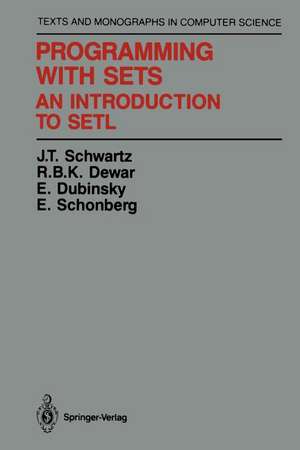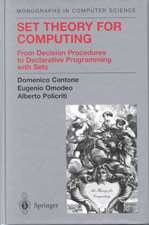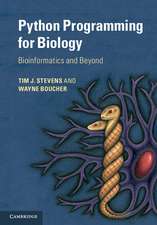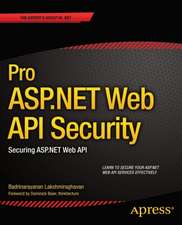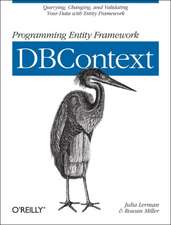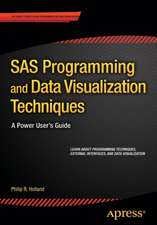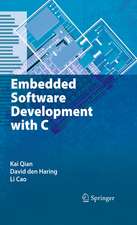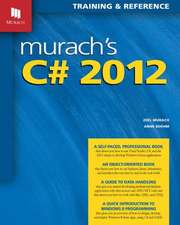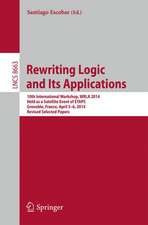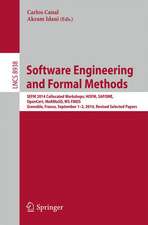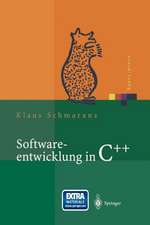Programming with Sets: An Introduction to SETL: Monographs in Computer Science
Autor J.T. Schwartz, R. B. K. Dewar, E. Dubinsky, E. Schonbergen Limba Engleză Paperback – 4 ian 2012
Din seria Monographs in Computer Science
- 20%
 Preț: 1322.33 lei
Preț: 1322.33 lei - 20%
 Preț: 511.92 lei
Preț: 511.92 lei - 20%
 Preț: 1285.31 lei
Preț: 1285.31 lei - 20%
 Preț: 333.22 lei
Preț: 333.22 lei - 20%
 Preț: 328.60 lei
Preț: 328.60 lei - 15%
 Preț: 646.94 lei
Preț: 646.94 lei - 20%
 Preț: 357.48 lei
Preț: 357.48 lei - 20%
 Preț: 339.47 lei
Preț: 339.47 lei - 20%
 Preț: 653.21 lei
Preț: 653.21 lei - 20%
 Preț: 329.44 lei
Preț: 329.44 lei - 20%
 Preț: 993.74 lei
Preț: 993.74 lei - 20%
 Preț: 992.26 lei
Preț: 992.26 lei - 20%
 Preț: 1630.95 lei
Preț: 1630.95 lei - 20%
 Preț: 650.08 lei
Preț: 650.08 lei - 20%
 Preț: 328.09 lei
Preț: 328.09 lei - 20%
 Preț: 641.16 lei
Preț: 641.16 lei - 20%
 Preț: 334.38 lei
Preț: 334.38 lei - 18%
 Preț: 737.74 lei
Preț: 737.74 lei - 20%
 Preț: 642.19 lei
Preț: 642.19 lei - 20%
 Preț: 641.99 lei
Preț: 641.99 lei - 20%
 Preț: 345.59 lei
Preț: 345.59 lei - 20%
 Preț: 711.29 lei
Preț: 711.29 lei - 20%
 Preț: 1001.16 lei
Preț: 1001.16 lei - 20%
 Preț: 661.47 lei
Preț: 661.47 lei - 20%
 Preț: 343.62 lei
Preț: 343.62 lei - 20%
 Preț: 644.81 lei
Preț: 644.81 lei - 15%
 Preț: 505.30 lei
Preț: 505.30 lei - 20%
 Preț: 640.69 lei
Preț: 640.69 lei -
 Preț: 396.78 lei
Preț: 396.78 lei - 18%
 Preț: 956.81 lei
Preț: 956.81 lei - 20%
 Preț: 592.68 lei
Preț: 592.68 lei - 20%
 Preț: 329.44 lei
Preț: 329.44 lei -
 Preț: 383.33 lei
Preț: 383.33 lei - 20%
 Preț: 349.40 lei
Preț: 349.40 lei - 20%
 Preț: 832.40 lei
Preț: 832.40 lei - 20%
 Preț: 993.42 lei
Preț: 993.42 lei - 15%
 Preț: 578.87 lei
Preț: 578.87 lei - 20%
 Preț: 337.85 lei
Preț: 337.85 lei - 20%
 Preț: 988.16 lei
Preț: 988.16 lei - 20%
 Preț: 996.56 lei
Preț: 996.56 lei - 20%
 Preț: 1293.37 lei
Preț: 1293.37 lei - 20%
 Preț: 1452.94 lei
Preț: 1452.94 lei
Preț: 656.03 lei
Preț vechi: 820.04 lei
-20% Nou
Puncte Express: 984
Preț estimativ în valută:
125.54€ • 132.00$ • 103.73£
125.54€ • 132.00$ • 103.73£
Carte tipărită la comandă
Livrare economică 17 aprilie-01 mai
Preluare comenzi: 021 569.72.76
Specificații
ISBN-13: 9781461395775
ISBN-10: 1461395771
Pagini: 512
Ilustrații: XV, 493 p.
Dimensiuni: 155 x 235 x 27 mm
Greutate: 0.71 kg
Ediția:Softcover reprint of the original 1st ed. 1986
Editura: Springer
Colecția Springer
Seria Monographs in Computer Science
Locul publicării:New York, NY, United States
ISBN-10: 1461395771
Pagini: 512
Ilustrații: XV, 493 p.
Dimensiuni: 155 x 235 x 27 mm
Greutate: 0.71 kg
Ediția:Softcover reprint of the original 1st ed. 1986
Editura: Springer
Colecția Springer
Seria Monographs in Computer Science
Locul publicării:New York, NY, United States
Public țintă
ResearchCuprins
1 Programming Concepts.- 1.1 An Informal Overview of SETL.- 1.2 Advice to the Would-Be Programmer.- 1.3 Programming Steps: How to Run Your Program and Read Its Results.- 1.4 How to Type a Program: Character Sets.- 1.5 Appendix: More on How to Read Your Output Listing.- 2 Simple Data Types, Expressions, and Operations.- 2.1 The Main Classes of Data Objects.- 2.2 Simple Types and Their Constants.- 2.3 Variable Identifiers.- 2.4 Expressions and Statements.- 2.5 Operations with Simple Data Types.- 3 Compound Data Types and Operators.- 3.1 Sets and Set Denotations.- 3.2 Tuples.- 3.3 Maps.- 3.4 The Size of Composite Objects: The # Operator.- 3.5 Set Operations and Set Formers.- 3.6 Tuple Operations and Tuple Formers.- 3.7 Tuple Formers; Simple Tuple and String Iterators.- 3.8 Map Operations.- 3.9 Compound Operators.- 3.10 Types and Type-Testing Operators.- 3.11 The? Operator.- 3.12 General Form of the SETL Assignment: The Operators from, frome, and fromb.- 3.13 Operator Precedence Rules.- 3.14 Om and Errors.- 4 Control Structures.- 4.1 The if Statement.- 4.2 The case Statement.- 4.3 Loops.- 4.4 The goto Statement.- 4.5 The stop Statement.- 4.6 The assert Statement.- 4.7 Programming Examples.- 4.8 Reading and Writing Data.- 5 Procedures.- 5.1 Writing and Using Procedures.- 5.2 Name Scopes; Local and Global Variable Names: The var Declaration.- 5.3 Programming Examples 177 5.3.1 The buckets and well problem: a simple artificial intelligence example.- 5.4 Recursive Procedures.- 5.5 Procedures that Modify Their Parameters.- 5.6 Other Procedure-Related Facilities.- 5.7 Rules of Style in the Use of Procedures.- 5.8 String Scanning Primitives.- 5.9 Use of Atoms.- 6 Program Development, Testing, and Debugging.- 6.1 Bugs: How to Minimize Them.- 6.2 Finding Bugs.- 6.3 A Checklist of Common Bugs.- 6.4 Program Testing.- 6.5 Analysis of Program Efficiency.- 6.6 Formal Verification of Programs.- 6.7 Formative Influences on Program Development.- 6.8 References to Material on Alternative Data Structures: References for Additional Material on Algorithms.- 7 Backtracking.- 7.1 Backtracking.- 8 Structuring Large SETL Programs.- 8.1 The const Declaration.- 8.2 Macros.- 8.3 Programming Examples.- 8.4 Programs, Modules, Libraries, and Directories: Structuring Constructs for Large SETL Programs.- 9 Input/Output and Communication with the Environment.- 9.1 Input-Output Facilities.- 9.2 Use of Inclusion Libraries.- 9.3 Listing-Control Commands.- 9.4 Environment Operators and SETL Command Parameters.- 10 The Data Representation Sublanguage.- 10.0 Implementation of the SETL Primitives.- 10.1 The Standard Representation for Tuples.- 10.2 The Standard Representation for Sets.- 10.3 Type Declarations.- 10.4 Basing Declarations.- 10.5 Base Sets Consisting of Atoms Only.- 10.6 Constant Bases.- 10.7 The Packed Representations.- 10.8 Guidelines for the Effective Use of the Data Representation Sublanguage.- 11 The Language in Action: A Gallery of Programming Examples.- 11.1 Eulerian Paths in a Graph.- 11.2 Topological Sorting.- 11.3 The Stable Assignment Problem.- 11.4 A Text Preparation Program.- 11.5 A Simplified Financial Record-Keeping System.- 11.6 A Turing-Machine Simulator.- 11.7 Huffman Coding of Text Files.- 11.8 A Game-Playing Program.- 11.9 Implementation of a Macroprocessor.- Appendix A SETL Reserved Words.- Appendix B Syntax Diagrams.- B.1 Lexical Structure.- B.2 Program Structure.- B.3 Declarative Forms.- B.4 Statement Forms.- B.5 Expressions.
